Taken a rest from my history of global warming studies blog, been organizing new entries in my head. But more entries are coming soon I promise!
In the meantime a cartoon by the 2010 Pulitzer prize winner for editorial cartoons, Mike Keefe:
And I like this new video, adding it back after the outage:
And...for the very first time on record, the concentration of CO2 exceeded 393 ppm at Mauna Loa, during April 2011.
Which fits well with my new entry about Dr. Charles Keeling, coming soon!


I thought we would see more of a downturn or at least a slowdown with the world economic recession. Not to be I guess.
ReplyDeleteActually the 12 month rate of increase has slowed, with the La Nina promoting more marine CO2 absorption. However, that should start to speed up again as La Nina fades. CO2 at Mauna Loa peaks in May, and reaches its minimum in October or November. April and May set new highs every year.
ReplyDeleteThe Anthropocene is an interesting concept I've heard of for several years. The Geological Society of London is holding a conference on it. Geological periods are defined by identifiable changes in rocks. The year 1945 has been proposed as one date for the beginning of the Anthropocene, because of radioactive isotopes being identifiable. And I like it.
ReplyDeleteSome articles on it here: http://dotearth.blogs.nytimes.com/2011/05/11/confronting-the-anthropocene/
And here: http://www.bbc.co.uk/news/science-environment-13335683
The Anthropocene is worthy of a blog in itself--or books, and is beyond the scope of my blog. But I will be keeping an eye on this topic and posting about it as I see fit.
The 12-month rate of CO2 increase has slowed, primarily due to more CO2 absorption in the oceans as La Nina progressed. CO2 at Mauna Loa hits its peak in May, and falls until October, or sometimes November. April and May have set new highs every year for many years now. And the CO2 concentration in the atmosphere will accelerate its increase as La Nina fades and is replaced by the next El Nino. I think we will hit 400 ppm for CO2 in May 2014.
ReplyDeleteThe recession actually didn't have much effect on global CO2 emissions, mainly due to growth in China and India, which offset any decreases in the West.
ReplyDeleteAlso, speaking of La Nina, I think it is safe to say that it is gone, and atmospheric indicators certainly reflect that; the SOI has literally crashed over the last week or two, and trade winds have weakened with significant westerly anomalies appearing in the western Pacific; given that we are still within the ENSO changeover period (March-June), that is something to watch, especially since heat content is still high (Hansen predicts an El Nino this summer based on heat content, although 2008 had a similar progression, but a month or two later, perhaps too late for a changeover).
It is also interesting to note that tornado activity has dramatically declined this month, coinciding with the rapid drop in the SOI.
This is my first time i visit here. I found such a substantial number of interesting stuff in your blog especially its examination. Really its inconceivable article. Keep it up. تحصیل در انگلستان بدون مدرک زبان
ReplyDelete